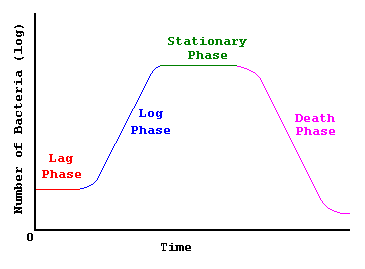Animals:- Plants:-
- competition for food and water - light intensity and temperature
- competition for mates - pH
- availability of burrows and space - water and nutrients
- predation - pollinators
- disease/parasitse - disease
Therefore, limiting factors can be either biotic or abiotic.
DENSITY DEPENDENT FACTORS have more impact as popoulation becomes more dense
DENSITY INDEPENDENT FACTORS affect the population in the same way regardless of density
CARRYING CAPACITY is the maximum population size that can be maintained over a period of time in a particular habitat
In a closed system, population growth will follow a standard pattern....
 |
| NOTE: we call death phase, declining phase instead
|
LAG PHASE = plateau before a steady increase as the species is acclimatising to conditions
LOG PHASE = expotential growth as represented very steep positive gradient of the line
STATIONARY PHASE = limiting factors start being influential and limit the size that the population can reach
DECLINING PHASE = limiting factors start to make the population size decrease
However, in a open system, as in nature, the pattern is slightly different....
This main difference, in nature, to the above closed system, is that the carrying capacity limits the population size, with limiting factors preventing the carrying capacity level to be exceeded
One of the most influential factors in dictated population size is the predator/prey relationship. Changes in one cause changes in the other, and generally speaking they run a 10 year cycle
Using the relationship between hares and lynx as an example:
- a small population of hares cannot support many lynx, so the lynx population crashes
- however, this means there are fewer lynx to prey on the hares, so the hare population starts to rise
- this, in turn, supports more lynx, so the lynx population starts to rise
- however, more lynx means more hares are eaten so the hare population falls - so the cycle has to start all over again!
However, to complicate this, when studying hare populations where there are no lynx, the hares still display a similar 10 year cycle! This implies that fluctuations in the number of hares affects the lynx population, but that number of lynx do not cause fluctuations in the hare population, to the same extent. So what do the result from....
- changes in availability of vegetation
- changes in the nutritional value of the available vegetation
- reduction in the breeding success of hares when the population density increases
Competition between organisms for resources and space is another abiotic limiting factor on population size and there are two forms of competition.......
INTRASPECIFIC = competition between members of the SAME species
---> density dependent factors that limit population growth = causes natural selection
INTERSPECIFIC = competition between members of DIFFERENT species
---> competitive exclusion, researched by Gausse in 1934 using two species of paramecium.
- Concluded that if two species occupy excatly the same niche, one would be out-competed and would become extinct in that habitat
NICHE = the role that a species plays in an ecosystem


